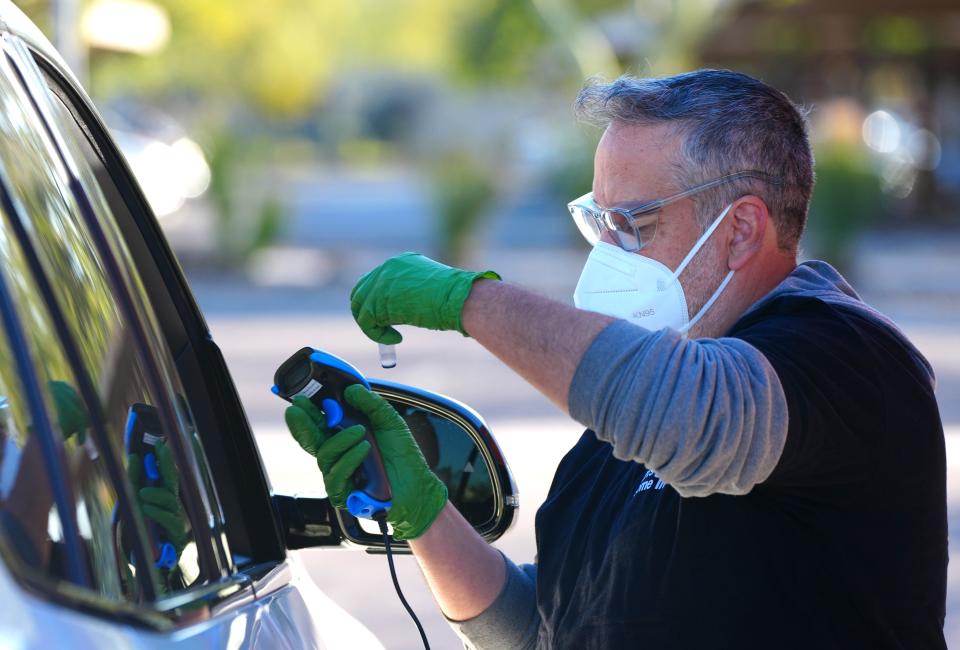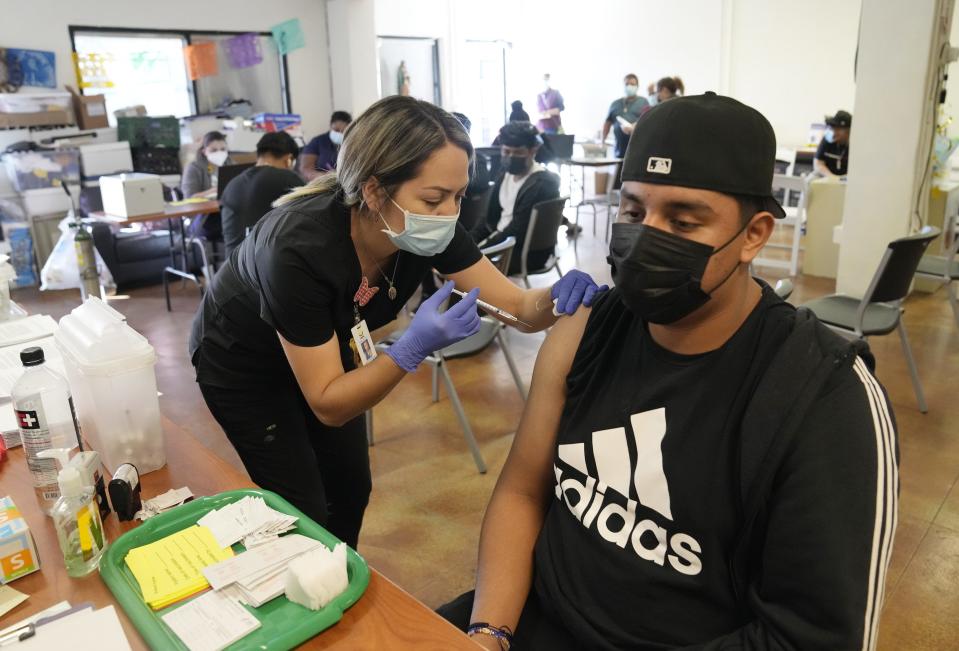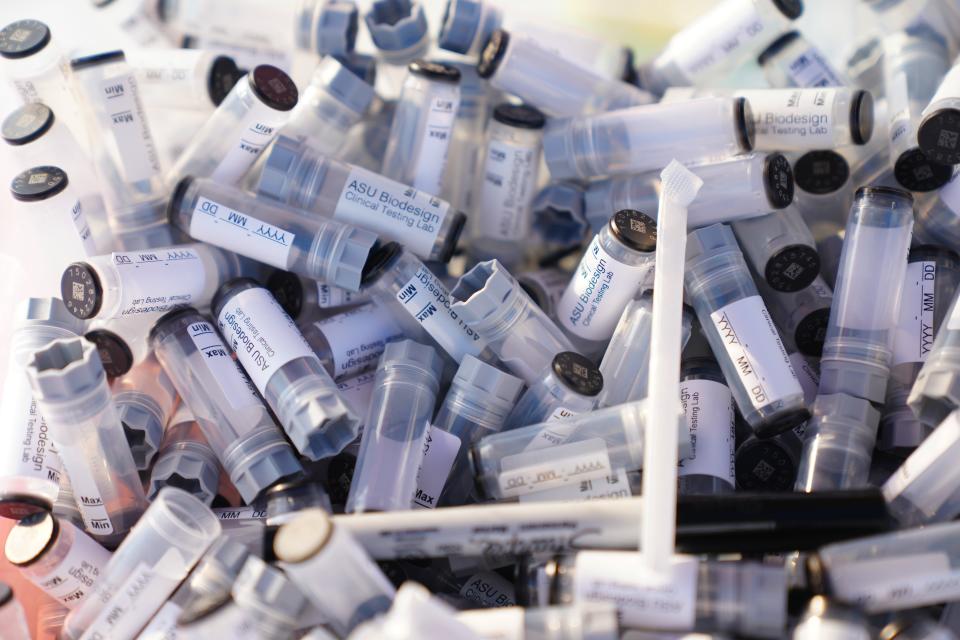COVID-19 weekly update: Arizona cases increase by 3,999, with 82 new known deaths
Reported COVID-19 cases in Arizona last week fell from the week prior to near the lowest level seen since the spring, according to the state's latest weekly update.
Health officials on Wednesday added 3,999 new COVID-19 cases and 82 new known deaths over the weeklong period ending Sept. 17. Recent weeks have seen relatively lower reported case counts.
Case counts are far below the winter, state data shows. Case numbers in recent months likely are not showing the full picture of infections as many more people have used at-home test kits and may not report positive results to their doctors or county health departments.
Some epidemiologists are predicting another wave of infections this fall and winter.
New Pfizer-BioNTech and Moderna booster formulations of the COVID-19 vaccine that specifically target omicron subvariants were granted emergency use authorization by the U.S. Food and Drug Administration at the end of August. The Moderna version is for anyone age 18 and older, while the Pfizer version is for individuals 12 years and older.
Arizona, like other states, has seen elevated cases largely driven by two contagious subvariants of the virus, BA.4 and BA.5, with BA.5 the more dominant of the two. It's also likely contributing to reinfections given its contagiousness and ability to evade antibodies.
The U.S. reported 15,850 deaths from COVID-19 in August, which was the highest national toll in several months, according to USA TODAY.
All 15 Arizona counties were designated as “low” in terms of COVID-19 levels, according to guidance from the Centers for Disease Control and Prevention as of Thursday. No counties were "high," at which point the CDC recommends people wear face masks indoors in public.
The CDC’s “community level” guidance metrics are based on a county’s COVID-19 hospital bed use, COVID-19 hospital admissions and case rates for the virus over the past week.
Reported cases since the pandemic began are over 2.2 million. Known deaths in Arizona are over 31,300.
Wednesday marked the 30th of the weekly updates to the state's data dashboard, instead of daily updates that Arizonans became accustomed to following for the latest data on infections, illnesses and deaths.

The previous week's update added 6,119 cases and 82 deaths, compared with 3,666 cases and 48 deaths three weeks ago and 8,661 cases and 67 deaths four weeks ago.
This week's update shows the differences between data reported for the week of Sept. 11-17 and Sept. 4-10.
Health officials say weekly updates match how public health monitors trends and other disease reporting.
Case numbers generally were relatively lower in the past couple of months, and public health experts estimate cases of the highly contagious omicron variant peaked in Arizona around mid-January.
The state data dashboard no longer shows key hospitalization information since Gov. Doug Ducey ended the COVID-19 emergency declaration on March 30. State health officials said hospitals are no longer required to report some COVID-19 surveillance data to the state, meaning certain graphs showing weekly hospitalization levels for the disease and bed usage by COVID-19 patients are no longer updated.
At the time that data reporting stopped, hospitalizations for the disease had dropped steadily since late January.
The CDC still reports state hospitalization data for Arizona and showed a 7% decrease in the seven-day average of COVID-19 hospital admissions during Sept. 12-18 compared with Sept. 5-11. Hospital admissions last week were down 92.5% from the peak seven-day average in early January 2021.
The number of known deaths in the state was at 31,326 as of Wednesday, after passing 30,000 known deaths in the May 4 update. The state surpassed 25,000 deaths on Jan. 13. Deaths are reported with a four-week lag.
The CDC places Arizona's overall pandemic death rate since early 2020 as the third-highest nationwide.
Arizona's breakthrough COVID-19 death rate was 0.06% as of Aug. 24
As of Aug. 24, there had been 2,883 breakthrough deaths in fully vaccinated individuals, according to state health officials’ preliminary data, which works out to a breakthrough death rate of about 0.06% among fully vaccinated people.
The state in December began publicly disclosing data on breakthrough COVID-19 infections, and state officials say the data underscores the effectiveness of the vaccine, especially for people up to date on all recommended COVID-19 doses, including boosters.
Data from July show that 44% of hospitalizations and 37.3% of COVID-19 deaths were among unvaccinated people, 50% of hospitalizations and 59.3% of deaths were among vaccinated but not up-to-date people, and 6% of hospitalizations and 3.4% of deaths were among people up-to-date on vaccination.
State health officials previously broke down hospitalization and death data for unvaccinated people and people with and without boosters, but said they changed the format for July to show the impact of staying up-to-date with a second booster shot plus future vaccine recommendations.
Unvaccinated people ages 5 and older had an 18 times greater risk of hospitalization and 47 times greater risk of dying from COVID-19 in July compared to people who were up-to-date on their vaccination. Unvaccinated people were 6.9 times more likely to be hospitalized and 7.2 times more likely to die from COVID-19 compared to people who were vaccinated but not up-to-date, per the state’s July analysis.
“Stronger protection from hospitalization and death is seen in those who are up-to-date on COVID-19 vaccinations,” interim state health director Don Herrington wrote in a blog post.

Health officials emphasize the best protection against severe illness from COVID-19 is to remain up to date with recommended vaccinations, including second booster doses for those 50 and older and people who are immunocompromised. The FDA recently authorized the new booster formulations as a single booster dose at least two months following primary or booster vaccination.
"The FDA has extensive experience with strain changes for annual influenza vaccines. We are confident in the evidence supporting these authorizations,” Dr. Peter Marks, director of the FDA’s Center for Biologics Evaluation and Research said in an Aug. 31 statement.
"We sought input from our outside experts on the inclusion of an omicron component in COVID-19 boosters to provide better protection against COVID-19. We have worked closely with the vaccine manufacturers to ensure the development of these updated boosters was done safely and efficiently."
Case rates and death reports
Contagious omicron subvariants, particularly BA.5, are contributing to many of the cases in Arizona, according to results from sequencing labs.
Percent positivity, which refers to the percentage of COVID-19 diagnostic tests that are positive, varies somewhat based on how it's measured. It was high in the winter months, a sign of more community spread. Then it was much lower but began climbing upward in April, and then back downward in recent weeks.
Arizona's percent positivity for COVID-19 testing was at 3% for the week of April 3, and went up in subsequent weeks. It was 29% for the week of July 10, 28% for the week of July 17, 27% for the week of July 24, and 24% for the week of July 31. It has since continued to go down — 21% for the week of Aug. 7, 17% for the week of Aug. 14, 14% for the week of Aug. 21, 12% for the week of Aug. 28, 12% for the week of Sept. 4 and 10% for the week of Sept. 11. The percentages are now for all diagnostic tests conducted, rather than for unique individuals tested, after a change to the state dashboard.
A positivity rate of 5% or less is considered a good benchmark that the disease's spread is under control.

The state's overall COVID-19 death and case rates since Jan. 21, 2020, still remain among the worst in the country.
The COVID-19 death rate in Arizona since the pandemic began is 429 deaths per 100,000 people as of Tuesday, according to the CDC, putting it third in the country in a state ranking that separates New York City from New York state. The U.S. average is 315 deaths per 100,000 people as of Tuesday, according to the CDC.
New York City has the highest death rate, at 497 deaths per 100,000 people, followed by Mississippi at 431.
Arizona's first known death from the disease occurred in mid-March 2020.
Many of the reported deaths occurred days or weeks before because of reporting delays and death certificate matching.
A total of 2,268,158 COVID-19 cases were identified across the state through Sept. 17.
Arizona is still behind the US vaccination rate
Arizonans ages 6 months and older are eligible for the Pfizer vaccine, while the Moderna vaccine is approved for children ages 6 months to 5 years and people 18 and older. The CDC has recommended the Johnson & Johnson vaccine on a more limited basis for people 18 and older. Many individuals are eligible for booster doses, too.
The state reported over 5.3 million people in Arizona — about 74.2% of the total state population — had received at least one vaccine dose through Sept. 17, with over 4.5 million residents fully vaccinated against COVID-19. The state’s data dashboard now separates out doses administered to Arizona residents versus all doses administered in the state.
Arizona's rate of fully vaccinated people out of the total population was 63.2%, which was behind the national rate of 67.7%, according to the CDC as of Sept. 14.
There's a wide range of vaccine uptake across the U.S. About 85.1% of the total population of Rhode Island was fully vaccinated, which is the highest rate in the U.S. In Wyoming, which has the lowest rate, just 51.9% of the population was fully vaccinated, per the CDC.
Out of people ages 5 and older, 67.1% of those in Arizona were fully vaccinated, compared with 71.8% at the national level, CDC data shows.
Health experts strongly recommend booster shots for those eligible, especially with the omicron variant spreading. About 48.2% of fully vaccinated Arizonans over the age of 18 had received a first booster shot as of Sept. 14, below the national rate of 51.7% for that same age group.
What to know about latest numbers
Reported cases in Arizona: 2,268,158, as of Sept. 17.
Cases by county: 1,423,388 in Maricopa; 290,693 in Pima; 147,217 in Pinal; 67,629 in Yuma; 63,550 in Mohave; 54,922 in Yavapai; 49,546 in Coconino; 44,097 in Navajo; 36,043 in Cochise; 31,197 in Apache; 19,780 in Gila; 18,504 in Santa Cruz; 13,381 in Graham; 5,746 in La Paz; and 2,465 in Greenlee, according to state numbers.
The rate of cases per 100,000 people since the pandemic began is highest in Apache County, followed by Navajo, Gila, Santa Cruz, Graham and Coconino counties, according to state data. The rate in Apache County is 43,445 cases per 100,000 people. By comparison, the U.S. average rate since the pandemic began is 28,781 cases per 100,000 people as of Tuesday, according to the CDC.
The Navajo Nation reported 73,591 cases and 1,900 confirmed deaths as of Tuesday. The Navajo Nation includes parts of Arizona, New Mexico and Utah.
COVID-19 relief: Navajo Nation to spend $1B in recovery funds after pandemic strikes community
The Arizona Department of Corrections reported 15,479 inmates had tested positive for COVID-19 as of Tuesday, the highest number at its Tucson facility with 2,467 confirmed positive cases. A total of 5,683 prison staff members have self-reported testing positive, the department said. Sixty-three incarcerated people in Arizona are confirmed to have died of COVID-19, with six additional deaths under investigation.
The race/ethnicity breakdown of cases since the start of the pandemic in 2020 is 40% white, 29% Hispanic or Latino, 5% American Indian, 4% Black and 2% Asian/Pacific Islander. Race/ethnicity of positive cases since the onset of the pandemic is unknown in 14% of cases and listed as other races in 6% of cases.
Of those who have tested positive in Arizona since the start of the pandemic, about 21% were younger than 20, 42% were 20-44, 13% were 45-54, 11% were 55-64 and 13% were age 65 or older.
Laboratories had completed 20,817,607 total diagnostic tests for COVID-19 as of Sept. 10, 12.6% of which have come back positive. That number includes both PCR and antigen testing.
Percent positivity was at 10% for the week of Sept. 11, lower than in previous weeks but still at a high level. The state numbers leave out data from labs that do not report electronically.
The state Health Department includes probable cases as anyone with a positive antigen test, another type of test to determine infection. Antigen tests (not related to antibody tests) use a nasal swab or another fluid sample to test for current infection. Results are typically produced within 15 minutes.
A positive antigen test result is considered very accurate, but there's an increased chance of false-negative results, Mayo Clinic officials said. They say a doctor may recommend a PCR (polymerase chain reaction) test to confirm a negative antigen test result.
Arizona as of Tuesday had the 16th highest overall case rate of all U.S. states and territories since Jan. 21, 2020, per the CDC. Ahead of Arizona in cases per 100,000 people since the pandemic began are Alaska, Rhode Island, Kentucky, North Dakota, Guam, Tennessee, New York City, West Virginia, South Carolina, Florida, Utah, Wisconsin, Delaware, Arkansas and Louisiana, according to the CDC.
Arizona's infection rate is 31,107 cases per 100,000 people, according to the CDC. The national average is 28,781 cases per 100,000 people, although the rates in states hard hit early in the pandemic may be an undercount because of a lack of available testing in March and April 2020.
Reported deaths in Arizona: 31,326
Deaths by county: 17,910 in Maricopa; 3,996 in Pima; 1,726 in Pinal; 1,543 in Mohave; 1,284 in Yavapai; 1,205 in Yuma; 939 in Navajo; 624 in Apache; 595 in Cochise; 496 in Coconino; 397 in Gila; 238 in Santa Cruz; 183 in Graham; 151 in La Paz; and 39 in Greenlee.
People age 65 and older make up 22,365 of the 31,326 deaths, or 71%. About 15% of deaths were among people 55-64 years old, 8% were 45-54 and 5% were 20-44 years old.
While race/ethnicity was unknown for 4% of deaths, 56% of those who died were white, 26% were Hispanic or Latino, 7% were Native American, 3% were Black and 1% were Asian/Pacific Islander, the state data shows.
The global death toll as of Wednesday was 6,530,050. The U.S. had the highest death count of any country in the world, at 1,054,396, followed by Brazil at 685,428 and India at 528,403, according to Johns Hopkins University.
Arizona's 31,326 deaths represent about 3% of COVID-19 deaths in the United States.
Republic reporter Stephanie Innes contributed to this article.
Reach the reporter at Alison.Steinbach@arizonarepublic.com or at 602-444-4282. Follow her on Twitter @alisteinbach.
Support local journalism. Subscribe to azcentral.com today.
This article originally appeared on Arizona Republic: Arizona weekly COVID-19 update adds 3,999 cases, 82 deaths

